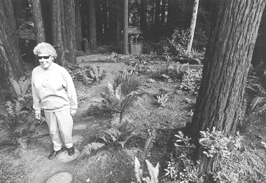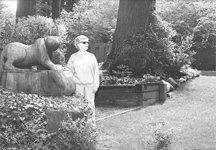

by Terry Kramer
 WHEN CARLOTTA GARDENER Jill O'Connell strolls through her garden with a morning cup of tea, she feels a breeze that sweeps up the Van Duzen River, sifting through a redwood canopy towering above her one-acre plot. Her feet crunch on crushed-gravel paths which meander about the woodland area. A nervous hummingbird whizzes past her ear. There is a faint, sweet scent of the pink jasmine as it scrambles up an arched redwood trellis toward a shaft of warm sunlight streaming through the trees.
WHEN CARLOTTA GARDENER Jill O'Connell strolls through her garden with a morning cup of tea, she feels a breeze that sweeps up the Van Duzen River, sifting through a redwood canopy towering above her one-acre plot. Her feet crunch on crushed-gravel paths which meander about the woodland area. A nervous hummingbird whizzes past her ear. There is a faint, sweet scent of the pink jasmine as it scrambles up an arched redwood trellis toward a shaft of warm sunlight streaming through the trees. Textures, scents and sounds. All are key elements in O'Connell's garden because she is blind. A member of the Humboldt Botanical Garden Foundation, she has agreed to have her garden featured on the annual fund-raising tour this month.
One would think that lacking sight would be this 75-year-old gardener's greatest challenge. It isn't. Gardening in the middle of a dense redwood forest is, in her opinion. First of all, there is not enough sunlight to grow her favorite redolent plants like stock and sweetpeas.
"A lot of the plants and flowers that have fragrance really do need a lot of sun. That's the problem, so when I find something that works for me, that has both fragrance and doesn't need a lot of sun, like mock orange, I feel lucky," she said.
For fragrance in the shade she depends on rhododendrons like King George and Elsie Fry along with a treasured Daphne odora.
O'Connell also has to contend with greedy, shallow redwood tree roots in a heavy clay soil.
"Actually, in an area like this you have to do a lot of raised beds. The soil is pretty heavy, and it's so acid. Then there are the redwood roots. They extend so far and they are not deep. I found that in order to do anything I had to go to raised beds and raised mounds," she said.
In spite of the environmental difficulties, O'Connell with help from her partner, Mel Brown has carved a refreshing woodland landscape where she combines native plants with non-natives to create naturalistic style.
Crushed-gravel paths wind throughout front, side and back yards smoothly connecting each space. Beneath each clump of redwood trees O'Connell has mounded raised beds bordered with bender board and sometimes smooth river stones. She has fashioned them into islands brimming with shade-loving plants including bleeding heart, ferns, hostas, mosses, trilliums, foxgloves, hellebores and fuchsias.
Colorful rhododendrons are featured prominently in the backyard, along with Japanese maple and heavenly bamboo. Trickling water fountains grace both front and rear yards.
O'Connell divided her yard into what landscape designers call rooms. Each has a name. The Wishing Well garden is an area that features a wishing well disguising a recently installed well. Lovers' Walk is a nature trail descending into the garden from a nearby cabin where her newlywed children had stayed.
A large area of the garden is called the Lion's Den because a huge chainsaw sculptured mountain lion overlooks the area from atop a redwood stump. This is the sunniest part of the yard and was designed professionally. Central to this formal, classical-style area is a square patch of lawn that features a flowering cherry planted in memory of her husband.
 "I started naming areas in the garden because it made it easier for me to tell people what I was talking about, and for them to tell me what they were talking about," she said.
"I started naming areas in the garden because it made it easier for me to tell people what I was talking about, and for them to tell me what they were talking about," she said.
Blind since birth, O'Connell began gardening eight years ago. Many of her favorite landscape plants are the ones that have tactile value, like burly, stiff hellebores, coarse spore-laden and fat hostas with ribbed leaves.
"Sounds and smells are important things in the garden, but just as much to me is actually the tactile sense of these plants. There is just no other way to describe it. Where you guys see, I feel it. And you know, it would be great if I could see it too, but since I can't, I do the next best thing."
One of her favorite tactile plants is the hosta, and she hunkers on haunches to feel them.
"Actually I intend to plant more hostas," she said. "They are fun and I love them from the day they sprout. I love the feel of the way they unfold and there is just something about the way they open up.
"When they are first coming on little things are pushing up out of the ground and I think `What is that going to be?' Every day, almost, I can tell the difference in leaf size and structure. I love that," she said. "I don't think most people think of feeling things, and so of course a lot of what I choose has to do with texture."
Before choosing a plant for her garden, O'Connell researches it, using a book called the Garden Primer by Barbara Damrosch. It is written in Braille and is on permanent loan to her from the Library of Congress. She also consults with a landscape designer on occasion and has someone come in once a week to weed.
"My problem is figuring out which is a weed and which isn't. So If I'm not absolutely certain, I leave it alone for somebody else to do," she said with a laugh.
Not seeing what she grows has not deterred O'Connell from gardening, and she believes it should not prevent others either.
"What I really feel about it is that a lot of older people start to lose some of their vision and they feel so defeated like there is nothing they can do.
"Gardening is so fun and it's such a wonderful excuse to be outdoors. I would hate to think that someone would give it up if they start losing their vision. They may feel like it's not the same. Of course it's not. But I think it's still worthwhile in its own right," she said.
Because she loves being outdoors O'Connell said she spends several hours a day in the garden, especially on the weekends.
"In the morning I come out with my cup of tea and sit on the bench and listen to the water; and I think there isn't any other place I'd rather be," she said.